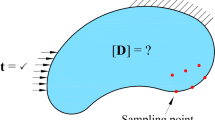Summary
The paper investigates special forms of the constitutive equations of the flow theory and extends the concept of proportional loading to finite deformations for the interpretation of the finite laws of the deformation theory of plasticity as the integral of the differential laws of the flow theory.
Similar content being viewed by others
References
Reckling, K.-A.: Plastizitätstheorie und ihre Anwendung auf Festigkeitsprobleme. Berlin Heidelberg New York: Springer 1967.
Hencky, H.: Zur Theorie plastischer Deformationen und der hierdurch im Material hervorgerufenen Nachspannungen. ZAMM4, 323–334 (1924).
Chen, W. F., Han, D. I.: Plasticity for structural engineers. New York Berlin Heidelberg: Springer 1988.
Budiansky, B.: A reassessment of deformation theories of plasticity. J. Appl. Mech.26, 259–264 (1959).
Rice, J. R., Rosengren, G. F.: Plane strain deformation near a crack tip in a power law hardening material. J. Mech. Phys. Solids16, 1–12 (1968).
Hutchinson, J. W.: Singular behaviour at the end of a tensile crack in a hardening material. J. Mech. Phys.16, 13–31 (1968).
Green, A. E., Naghdi, P. M.: A general theory of an elastic-plastic continuum. Arch. Rat. Mech. Anal.18, 251–281 (1965).
Lee, E. H., Liu, D. T.: Finite-strain elastic-plastic theory with application to plane-wave analysis. J. Appl. Physics38, 19–27 (1967).
Sedov, L. I.: O ponjatijach prostogo nagruženija o vosmožnych putjach deformacii. Prikl. Mat. Mech.23, 400–402 (1959).
Kačanov, L. M.: Osnovy teorii plaszičnosti, Moskva: Nauka 1969.
Yang, W. H.: Axisymmetric plane stress problems in anisotropic plasticity. J. Appl. Mech.36, 7–14 (1969).
Majlessi, S. A., Lee, D.: Further development of sheet metal forming analysis method. J. Eng. Ind.109, 330–337 (1987)
Stören, S., Rice, J. R.: Localized necking in thin sheets. J. Mech. Phys. Solids23, 421–441 (1975).
Hutchinson, J. W.: Elastic-plastic behaviour of polycrystalline metals and composites. Proc. Roy. Soc. London Ser.A319, 247–272 (1970).
Landgraf, G.: Probleme bei der Berechnung der Umformung von Blechen. In: Problemseminar Flächentragwerke IV (Landgraf, G., ed.), Dresden: TU-Weiterbildungszentrum Festkörpermechanik, Konstruktion und rationeller Werkstoffeinsatz 1985.
Landgraf, G., Modler, K.-H., Ziegenhorn, M.: Forming of shells. VDI-Berichte Nr 894, 293–305 (1991).
Truesdell, C., Toupin, R. A.: The classical field theories, Handbuch der Physik, Bd III/1. Berlin Göttingen Heidelberg, Springer 1960.
Hill, R.: Aspects of invariance in solid mechanics. Adv. Appl. Mech.18, 1–75 (1978).
Krawietz, A.: Materialtheorie. Berlin Heidelberg New York Tokyo: Springer 1986.
Hencky, H.: Über die Form des Elastizitätsgesetzes bei ideal elastischen Stoffen. Z. techn. Physik9, 215–220 (1928).
Becker, E., Bürger, W.: Kontinuumsmechanik. Stuttgart: Teubner 1975.
Duszek, M. K., Lodygowski, T.: On influence of some second order effects on the post-yield behaviour of plastic structures. In: Plasticity today (Sawczuk, A., Bianchi, G., eds.), pp. 413–427. London, England 1985.
Ehlers, W.: Poröse Medien—ein kontinuumsmechanisches Modell auf der Basis der Mischungstheorie. Forschungsberichte aus dem Fachbereich Bauwesen47, Essen: Universität-Gesamthochschule 1989.
Wegener, K.: Zur Berechnung großer plastischer Deformationen mit einem Stoffgesetz vom Überspannungstyp. Braunschweiger Schriften zur Mechanik 2/91, TU Braunschweig 1991.
Dafalias, Y. F.: Corotational rules for kinematic hardening at large plastic deformations. J. Appl. Mech.50, 561–565 (1983).
Dogui, A., Sidoroff, F.: Large strain formulating of anisotropic elasto-plasticity for metal forming. In: Comp. methods for predicting material processing defects (Preoleleanu, H., ed.), pp. 81–92. Amsterdam: Elsevier 1987.
Lubarda, V. A., Lee, E. H.: A correct definition of elastic and plastic deformation and its computational significance. J. Appl. Mech.48, 35–40 (1981).
Lehmann, T.: On the concept of stress-strain relations in plasticity. Acta Mech.42, 263–275 (1982).
Nemat-Nasser, S.: On finite deformation elasto-plasticity. Int. J. Solids Struct.18, 857–872 (1982).
Simo, J. C., Ortiz, M.: A unified approach to finite deformation elastoplastic analysis based on the use of hyperelatic constitutive equations. Comp. Meth. Appl. Mech. Eng.49, 221–245 (1985).
Wriggers, P., Stein, E.: Die Verwendung von Lie-Ableitungen bei der Angabe von Spannungsflüssen für große Deformationen. ZAMM68, T264-T267 (1988).
Balke, H.: Zur Anisotropie deformierbarer Körper bei großen Verformungen. ZAMM66, 227–232 (1986).
Author information
Authors and Affiliations
Rights and permissions
About this article
Cite this article
Bergander, H. Finite plastic constitutive laws for finite deformations. Acta Mechanica 109, 79–99 (1995). https://doi.org/10.1007/BF01176818
Received:
Issue Date:
DOI: https://doi.org/10.1007/BF01176818




